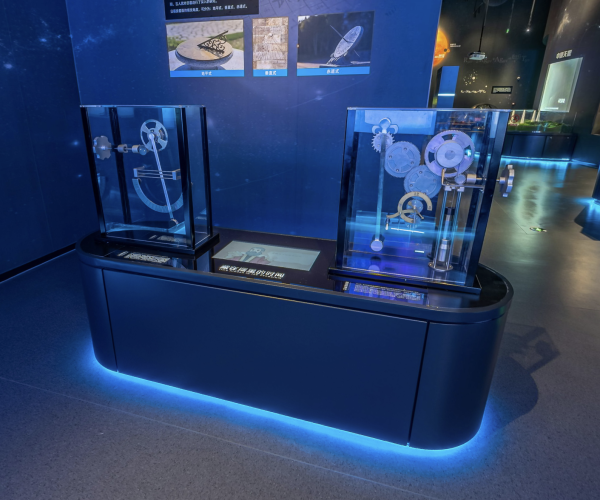
Pendulum and Huygens Clock Exhibit
Pendulum and Huygens Clock interactive exhibit brings to life the groundbreaking discoveries of Galileo Galilei and Christiaan Huygens, two pioneers in the study of timekeeping and harmonic motion. Visitors can engage with both a Galilean pendulum and a Huygens clock mechanism, gaining hands-on experience with the fundamental principles that shaped modern horology and physics.
Visitor Experience
The Pendulum and Huygens’ Clock Exhibit is divided into two interactive sections on a tabletop display:
Left Side – The Galileo Pendulum: Visitors rotate a handle to trigger the motion of a freely swinging pendulum. This simple yet powerful mechanism demonstrates isochronism, the property discovered by Galileo that ensures a pendulum’s swing remains consistent regardless of its amplitude.
Right Side – The Huygens Clock Mechanism: Visitors rotate another handle to lift an activation weight. Upon release, the clock mechanism comes to life, demonstrating how a controlled pendulum motion regulates timekeeping. The system mimics the first pendulum clocks designed by Christiaan Huygens in the 17th century, a breakthrough that revolutionized accuracy in time measurement.
Lessons Learned in 3D Constellations Exhibit
The pendulum is one of the most fundamental elements in physics and engineering. Galileo’s discovery that pendulums swing at a constant rate, regardless of the size of their swing, laid the foundation for precise timekeeping. This property, called isochronism, allowed Huygens to invent the pendulum clock, which remained the most accurate timekeeping device for centuries.
The Huygens clock mechanism improved on Galileo’s principles by introducing a controlled release of energy through a system of gears and an escapement mechanism. This innovation led to accurate mechanical clocks, a crucial advancement for navigation, astronomy, and everyday life.
By interacting with the Pendulum and Huygens’ Clock Exhibit, visitors will:
- Observe how pendulums maintain consistent oscillations.
- Understand the principle of isochronism and its role in timekeeping.
- Learn how energy transfer and controlled release enable mechanical clocks to function.
- Appreciate the historical impact of Galileo and Huygens in shaping modern science.
The exhibit provides a hands-on approach to classical mechanics, making it an engaging learning experience for students, educators, and science enthusiasts alike.
Target Age for Pendulum Exhibit
- From 5

